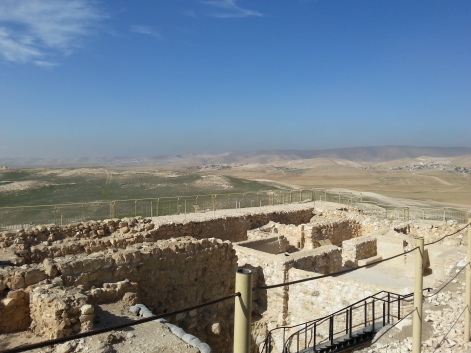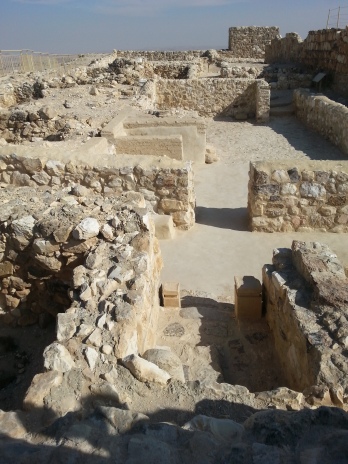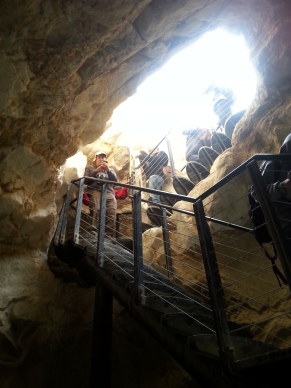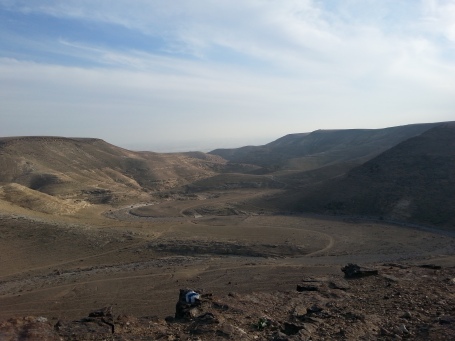Yesterday saw the third field trip in the current Yad Ben Zvi series of Bible tours, “929 on the map of Israel“, about which I have written in the past, on more than one occasion. We are now well into the study of the so-called “Twelve Minor Prophets” and today, we finished the reading of the third and final chapter of The Book of Habakkuk. The Yad Ben Zvi field trips, however, take place only once a month and cannot possibly cover all the smaller books of the Bible. They have to pick and choose. Yesterday’s field trip was therefore devoted to a prophet whom we actually finished reading several weeks ago – Obadiah.
The Book of Obadiah must surely be the shortest book in the entire Bible, consisting, as it does of only one chapter – a mere 21 verses. Moreover, that one chapter is addressed, not to Israel or Judah, but to Edom.
We do not know exactly who Obadiah was. With most of the other prophets, we know at least their father’s names and where they came from, and often, they tell us in whose reign they prophesied. But Obadiah is anybody’s guess. The Talmud tells us he was that same Obadiah who was in charge of the household of Ahab, son of Omri, King of Israel (and husband of the infamous Queen Jezebel) and that he was, himself, an Edomite convert to Judaism. On the other hand, many scholars believe that the language of the book indicates that Obadiah actually witnessed the fall of Jerusalem to the Babylonians, and the treacherous behaviour of the Edomites at that time, over two and a half centuries after Ahab’s reign, and so could not have been the same man.
At any rate, in order to understand the Book of Obadiah, it is important to remember that the hostility (if that is not too mild a word to use) between Israel/Judah and Edom went back many generations – even before the birth of Esau and Jacob, from whom they were descended.
The Bible tells us (Genesis 36:1) that Esau and Edom were one and the same. In addition, we are told (Genesis 25:21-26) that the brothers struggled with each other while still in their mother Rebekah’s womb and that God told her: “Two nations are in thy womb, and two peoples shall be separated from thy bowels; and the one people shall be stronger than the other people; and the elder shall serve the younger.”
We also learn that hundreds of years later,the Edomites refused passage to the Israelite former slaves, on their journey from Egypt to the Promised Land (See Numbers 20:14-21). In their request, the Israelites refer to the kinship (“your brother”) between themselves and the Edomites. It is this relationship which makes the behaviour of the Edomites so execrable in the eyes of Obadiah (Obadiah v.10, v.12).
“For the violence done to thy brother Jacob shame shall cover thee, and thou shalt be cut off for ever…..But thou shouldest not have gazed on the day of thy brother in the day of his disaster, neither shouldest thou have rejoiced over the children of Judah in the day of their destruction; neither shouldest thou have spoken proudly in the day of distress.”
Bearing all this in mind, we set off yesterday, on an unusually mild day (for January), in search of Edom (or, at least, Edom in their expansionist mode) in the northern Negev. (Edom’s heritage, according to the Bible, was beyond the River Jordan, in today’s Kingdom of Jordan.)
Our first stop was Tel Arad. Arad is mentioned in the Bible (Numbers 21:1), in connection with the hostile actions of its king against the Israelites. There are Canaanite remains at Tel Arad, but it was the later levels which interested us. Tel Arad was one of a series of fortresses guarding the southern approaches of the Kingdom of Judah against Edomite encroachment. Archaeological excavations have unearthed many layers of settlement, pre-Israelite, Israelite and post-Israelite. One of the most interesting is the fortress from the 8th century BCE, which contained a Sanctuary which appears to have been a scaled-down version of the Temple in Jerusalem, with a hall, shrine and Holy of Holies.

The ruins of the Sanctuary can be seen in the lower right hand corner.

Close-up of the Sanctuary, with the Holy of Holies and two incense altars in the foreground
You may recall that in the Book of Kings, we are told of each king in turn either that “he did that which was evil in the eyes of the Lord”, or that “he did that which was right in the eyes of the Lord”, but even of the latter, there is the almost inevitable rider “Howbeit the high places were not taken away; the people still sacrificed and offered in the high places.” This is not necessarily to be taken as meaning that they worshipped other gods but that, in violation of the prohibition on bringing sacrifices to the God of Israel anywhere but at the Temple in Jerusalem, they set up altars to Him in other places. It is possible that there was a measure of religious syncretisation, with offerings being made, both to the God of Israel and to foreign (Canaanite) gods, as we shall see shortly. It appears that the Sanctuary found at Tel Arad (as well as similar temples elsewhere in Israel and Judah) was one of these “high places”.
It is not until we reach the reign of Hezekiah, that we find a King of Judah who not only “did that which was right in the eyes of the LORD, according to all that David his father had done” but also put in place a religious reformation and “removed the high places, and broke the pillars, and cut down the Asherah”.
If we look closely at the Holy of Holies in the Sanctuary at Tel Arad, we can see two standing stones and two incense altars, still containing remnants of incense. Why two? It is possible that this indicates joint worship of the God of Israel and the female deity, Asherah. At all events, this Sanctuary was destroyed sometime in the 8th century BCE (round about the time of the reign of Hezekiah), by the building of a wall right through it, but the incense altars, instead of being smashed, or re-used in later building, had been laid reverently on their sides and that is how they were found, two and a half millenia later. This might be because they did, indeed, serve in the worship of the God of Israel and so those responsible for abolishing “the high places” would not have wished to destroy them utterly, but preferred to store them (Genizah), as Torah scrolls are stored, prior to religious burial, but never destroyed. Or, possibly, those who participated in some form of syncretised worship of the God of Israel and the Asherah, faced with the order to cease, merely “stored” the altars, with the hope of returning to them at some time in the future, when the government in Jerusalem was more favourable to such things, or, at least, ready to turn a blind eye. It is impossible to know for sure.
Another important find at Tel Arad was a collection of dozens of ostraca, many of which date to the last decades before the Babylonian conquest of Judah (597 BCE). The Edomites, as we know, sided with Babylon and therefore it is easy to understand the alarm evident in ostraca #24 and #40.
#24
“From Arad 50 and from Kin[ah]…
and you shall send them to Ramat-Negev by the hand of Malkiyahu the son of Kerab’ur and he shall hand them over to Elisha the son of Yirmiyahu in Ramat-Negev, lest anything should happen to the city. And the word of the king is incumbent upon you for your very life! Behold, I have sent to warn you today: [Get] the men to Elisha: lest Edom should come there.“
#40
“Your son Gemar[yahu] and Nehemyahu gre[et] Malkiyahu; I have blessed [you to the Lor]d and now: your servant has listened to what [you] have said, and I [have written] to my lord [everything that] the man [wa]nted, [and Eshiyahu ca]me from you and [no] one [gave it to] them. And behold you knew [about the letters from] Edom (that) I gave to [my] lord [before sun]set. And [E]shi[yah]u slept [at my house], and he asked for the letter, [but I didn’t gi]ve (it). The King of Judah should know [that w]e cannot send the […, and th]is is the evil that Edo[m has done].”
The Arad fortress was also well-supplied with water, having a large reservoir, into which we descended via a tortuous, winding staircase.

I mentioned that Tel Arad was one of a series of fortresses guarding the southern approaches to the Kingdom of Judah. It is strategically positioned on high ground above the surrounding desert and is within view of other fortresses, such as our next stop, Hurvat ‘Uza, a multi-layered site where both Israelite and Edomite artefacts were found and which controls a strategic path into the Judean heartland, through Nachal Kina, which it overlooks.
The view over Nachal Kina is spectacular – and frightening. I was careful to stay well clear of the edge, fearful of the enormous drop to the riverbed below.

Nachal Kina is so-called because the Kenites settled there. The ancient name is preserved in the name by which it is known to the Bedouin – Wadi Kini. The Kenites were on friendly terms with the Israelites. For this reason, when King Saul attacked the Amalekites on the border with Egypt (ie. in the Negev), he warned the Kenites, who were living among them:
“And Saul said unto the Kenites: ‘Go, depart, get you down from among the Amalekites, lest I destroy you with them; for ye showed kindness to all the children of Israel, when they came up out of Egypt.’ So the Kenites departed from among the Amalekites.
And Saul smote the Amalekites, from Havilah as thou goest to Shur, that is in front of Egypt.” (I Samuel,15: 6-7)
The Kenites, therefore, moved eastwards and settled in the area of the wadi which now bears their name.
However, it is time to return to the Edomites. I mentioned that, at Hurvat ‘Uza, both Israelite (Judean) and Edomite artefects were found. I would like to mention in particular, an ostracon in Hebrew, listing Israelite names – men’s names, including their fathers’ name and their place of origin. According to our guide, this is part of a list of men called to serve in the fortress. Why else would you have men from different towns gathered together in one place? He likened it to IDF reserve duty (miluim) call-up papers.
As for the Edomite ostracon, from shortly after the fall of Jerusalem to the Babylonians, it illustrates for us the Edomite encroachment into Judean lands and explains Obadiah’s anger at the way the Edomites took advantage of the fall of Jerusalem to lay their hands on Judean possessions:
“In the day that thou didst stand aloof, in the day that strangers carried away his substance, and foreigners entered into his gates, and cast lots upon Jerusalem, even thou wast as one of them….Thou shouldst not have entered into the gate of My people in the day of their calamity; yea, thou shouldst not have gazed on their affliction in the day of their calamity, nor have laid hands on their substance in the day of their calamity.” (Obadiah v.11, v.13).
The days are short in January, so we did not have much more than an hour or so at Hurvat ‘Uza – having spent much longer than intended at Tel Arad. The day was already waning and with the setting of the sun, the wind was rising. It can get very cold at night in the Negev desert. We therefore had to cut short our visit, reluctantly, and return to the bus where we could sum up the day’s lesson in warmth and relative comfort, before heading home for Jerusalem.

Excellent post . I love reading about these tours you go on, I Learn so much.
Stick with me. There’s more to come 🙂
Wonderful that excavations continue to reveal so much about the past and how it collaborates with the ancient writings!
I participated in two or three archaeological excavations in my student days. It’s hard work, but it’s exhilarating when you actually find something!
Thank you Shimona. I’ve been reminded again of things I learnt (and sadly mostly forgot!) when I was studying in Israel.
I’m sure once you start thinking about it, it will all come back to you.
🙂
So Purretty. We are always amazed at da purroven history of da Bible. Bein’ believers, it just kinda adds credence to da authority of da Bible. Glad you enjoyed your tour. Mommy so wishes she coulda done somethin’ like dat. And sorry ’bout your eye. We’re sendin’ purrayers and hugs.
Luv ya’
Dezi and Raena
It adds credence – yes, and also understanding. On practically every one of these field trips, the guides point out (and demonstrate, de facto) how it is frequently impossible to understand the meaning of the written word, unless you are actually there on the ground, as it were.
I know that many of you out there are interested in the Bible and that many, if not most of you, can only dream of visiting the places where the events described therein took place, so I’m very happy to be able to take you with me on a kind of virtual tour. I realise how very fortunate I am to live here.
Hugs to you all.
I totally agree, Shimona! Being there brought the Bible to life in a way I never thought possible! To this day I remember standing, I think it was at Megiddo, imagining Jehu storming across the valley of Jezreel!!
How apt is this reply to we all of us who so wish we could be with you. What a glorious thing!
If I had the opportunity that you are showing us here, I would be transfixed. Nailed as it were, to the ground. Unmoving as I took it all in until prodded to go forward. Completely awash in the historical treasure that is Israel.